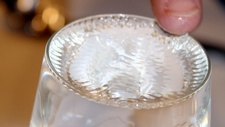Sound
Readiness

TEKS Objective
Explore the uses of energy including mechanical, light, thermal, electrical, and sound energy.
Essential Understanding
The student knows that energy occurs in many forms and can be observed in cycles, patterns, and systems.
Science Background
What is Sound? NOAA (website) - Students learn the basics of sound, including decibel scale, and work through more in depth content.
What is Sound?
The National Oceanic and Atmospheric Administration, www.pmel.noaa.gov
Science of Sound in the Sea: Office of Marine Programs (website) - Information about the movement of sound, particularly in oceans.
Science of Sound in the Sea
Office of Marine Programs, www.dosits.org
The Nature of a Sound Wave: The Physics Classroom (website) - Interactive, illustrated explanation and information about sound, how we sense it, sound waves, frequency and more. Includes links to additional resources for teachers and students and teachers.
The Nature of a Sound Wave
The Physics Classroom, http://www.physicsclassroom.com
Signature Lesson
Sound Wave: Utah Education Network (website) - Students explore and describe how sound is produced and learn uses for this type of energy.
Sound Wave
Utah Education Network, http://www.uen.org
Exploring Sound: K8Science (PDF) - Students rotate through stations for each activity below and record what they learn about sound at each station in their science notebooks.
- Supporting Lessons
- Extensions
- Assessment Ideas
- Literature Connections
- Related
TEKS - Additional Resources
Supporting Lessons
The Phenomenon of Sound - Waves: Discovery Education (website) - Students rotate through six “sound centers” and learn that sound is a form of energy that travels in waves through different forms of matter.
Physics at Your Desk, Drumming Fingers: American Physical Society (website) - Students investigate the movement of sound waves through a variety of materials.
Physics at Your Desk, Drumming Fingers
by the American Physics Society, www.physicscentral.com
Elaboration Lessons and Extensions
Hilarious Honker: TryScience (website) - Students discover how a plastic or paper cup affects sound vibrations.
Hilarious Honker
TryScience, www.tryscience.org
Exploring with Sound: TryScience (website) - Students use sound to determine the position of the objects making the sound.
Exploring with Sound:
TryScience, www.tryscience.org
Musical Coat Hangers: TryScience (website) - Students discover how sound travels and which materials provide the best sound conductivity.
Musical Coat Hangers
TryScience, www.tryscience.org
CANdemonium: Exploratorium (website) - Students fashion a musical instrument from recycled cans.
CANdemonium
Exploratorium, www.exploratorium.edu
Secret Bells: Exploratorium (website) - Students build a tool that increases the amount of sound reaching their ears.
Secret Bells
Exploratorium, www.exploratorium.edu
Ear Guitar: Exploratorium (website) - Students construct an “ear guitar” with cups and string, and hear the sound produced by string vibrations.
Assessment Ideas
Provide students with metal nails of several different lengths and have students arrange the nails in order, based on the sound they produce when struck with a pencil (e.g., from highest pitch to lowest pitch).
Literature Connections
Sound: Reading Essentials in Science. Karpelenia, J. (ISBN-13: 978-0756944520)
Max Found Two Sticks. Pinkney, B. (ISBN-13: 9780689815935)
Polar Bear, Polar Bear What Do You Hear? Martin, Bill (ISBN-13: 978-0312513467)
Simple First Sounds: Noisy Trucks. Priddy, Roger (ISBN-13: 978-0312509248)
Sound. Stille, Darlene (ISBN-13: 978-0756509781)
Adventures in Sound with Max Axiom, Super Scientist. Sohn, Emily (ISBN-13: 978-0736868365)
Additional Resources
What is Energy? K-12 Energy Education Program (website) - Students complete simple activities and experiments to learn about a various forms of potential energy.
What is Energy?
K-12 Energy Education Program, www.uwsp.edu
Your Ears: Kids Health (website) - This interactive article shows the structure of our ears and explains how humans hear sound.
Your Ears
Kids Health, http://kidshealth.org
Glass Xylophone: PBS Kids (website) - Make a “xylophone” from drinking glasses filled with different quantities of water and use it to explore sound energy, pitch and related concepts.
Glass Xylophone
PBS, http://pbskids.org
Sound Is Energy: Oracle ThinkQuest (website) - Interactive website devoted to sound energy, including the difference between noise and music. Includes graphics that illustrate pitch and volume and projects through which students can explore the properties of sound.
Sound is Energy
Oracle Thinkquest, http://library.thinkquest.org
TEKS Navigation
Grade 5
Need Assistance?
If you need help or have a question please use the links below to help resolve your problem.

Comments